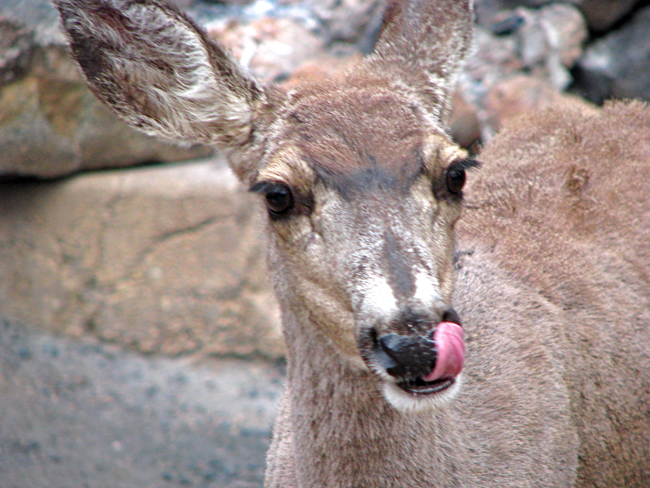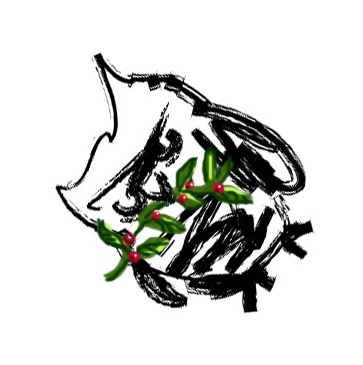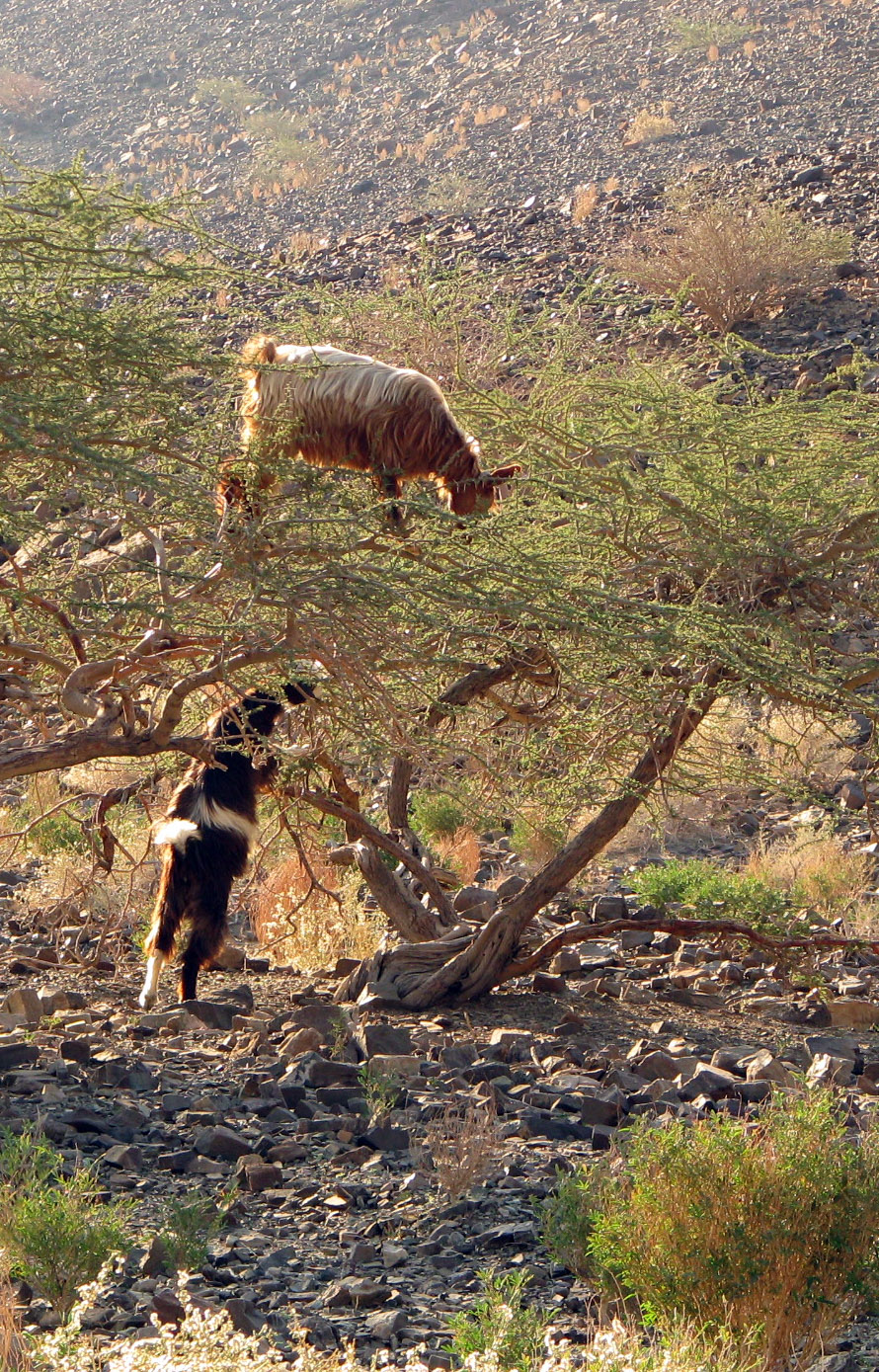Whew…
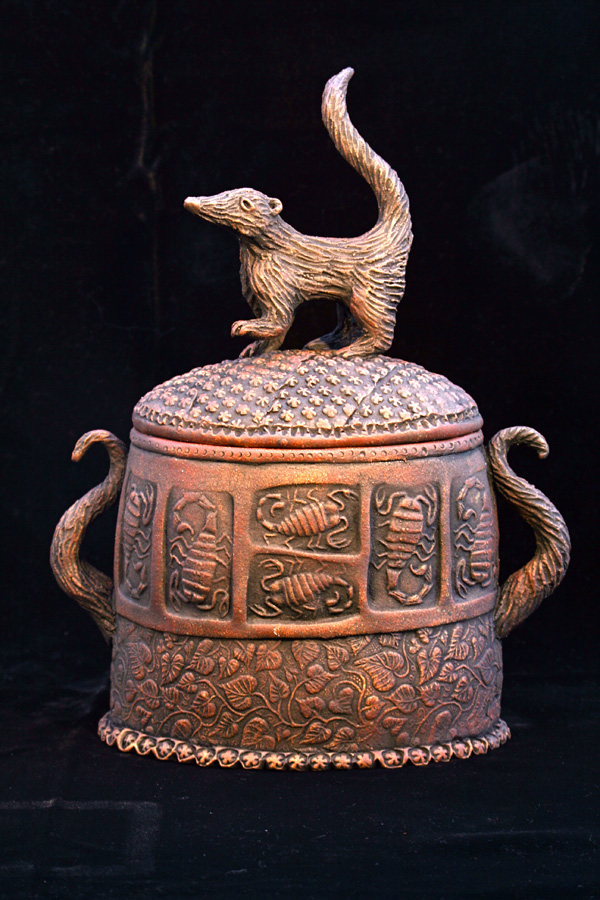 …back from Sierra Vista and Southwest Wings Festival; tired. Nice show. Thanks to everyone who came by, and thank you to the organizers, who did a good job in a new venue. It’s always nice to see friends, returning customers, and new faces.
…back from Sierra Vista and Southwest Wings Festival; tired. Nice show. Thanks to everyone who came by, and thank you to the organizers, who did a good job in a new venue. It’s always nice to see friends, returning customers, and new faces.
To those of you on my emailing list, if you’re wondering why you didn’t get an advance email notification of the event in your inbox, it’s because I absentmindedly forgot to send out an e-flyer before the show. Hope you found your way to the Three Star Owl booth anyway!
 Right: Coati/scorpion lidded vessel with coati-tail handles (A. Shock, 2010, stoneware, 9.5″ ht)
Right: Coati/scorpion lidded vessel with coati-tail handles (A. Shock, 2010, stoneware, 9.5″ ht)
Rock-watching in the wind
A few days ago, we drove far out into sage-covered lava rocks to check out some hot springs on the east side of the Sierra Nevada. After walking to the top of the hill, walking around the next hill and between two other hills, seeing what birds were around and 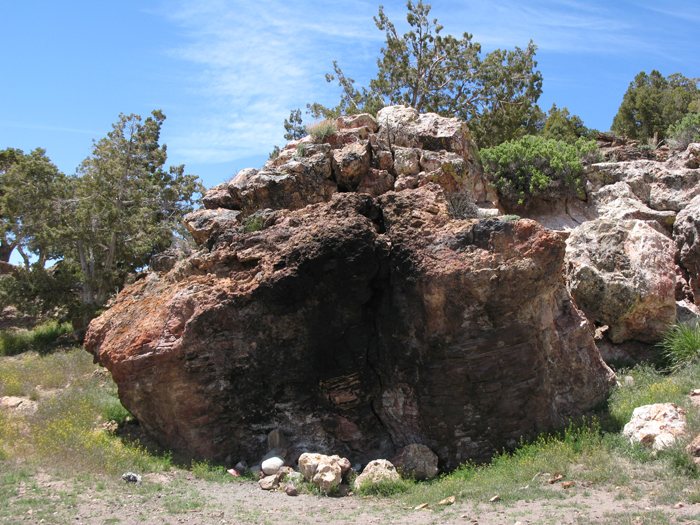 about, and while E was nearby doing Science in Hot Water, I felt I’d had enough wind — since we were above 7000′ feet, it was a cold wind — so I sheltered in the cab of the truck.
about, and while E was nearby doing Science in Hot Water, I felt I’d had enough wind — since we were above 7000′ feet, it was a cold wind — so I sheltered in the cab of the truck.
The rock I watched >>
If this seems like a nature-phobic sort of thing to do, let me recommend it: a vehicle makes a wonderful blind, great for observing otherwise human-wary wildlife. I watched a Wilson’s warbler, a sweet scrap of yellow with a smart black cap, struggle in the gusts from one juniper tree to another right in front of the hood; an Audubon’s warbler, too, was getting buffeted about in the same nearby trees. And, next to the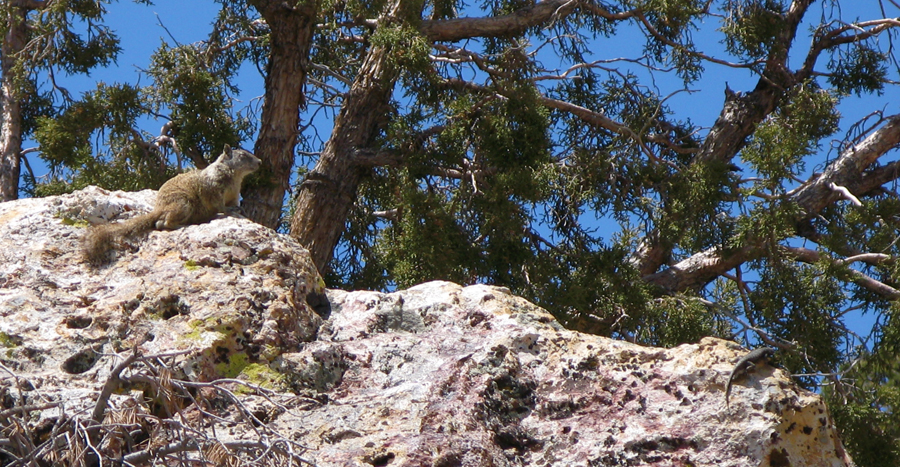 truck was this large Rock (top photo). I studied it, thinking about making a sketch.
truck was this large Rock (top photo). I studied it, thinking about making a sketch.
<< Ground squirrel and spiny lizard (far right edge of rock)
It was clear that this rock had been heavily used — most obviously by people, who’d built fires under it, but also by plants who’d sprouted in its cracks, lichens crusting its surfaces, and by animals, who were sunning themselves on it. 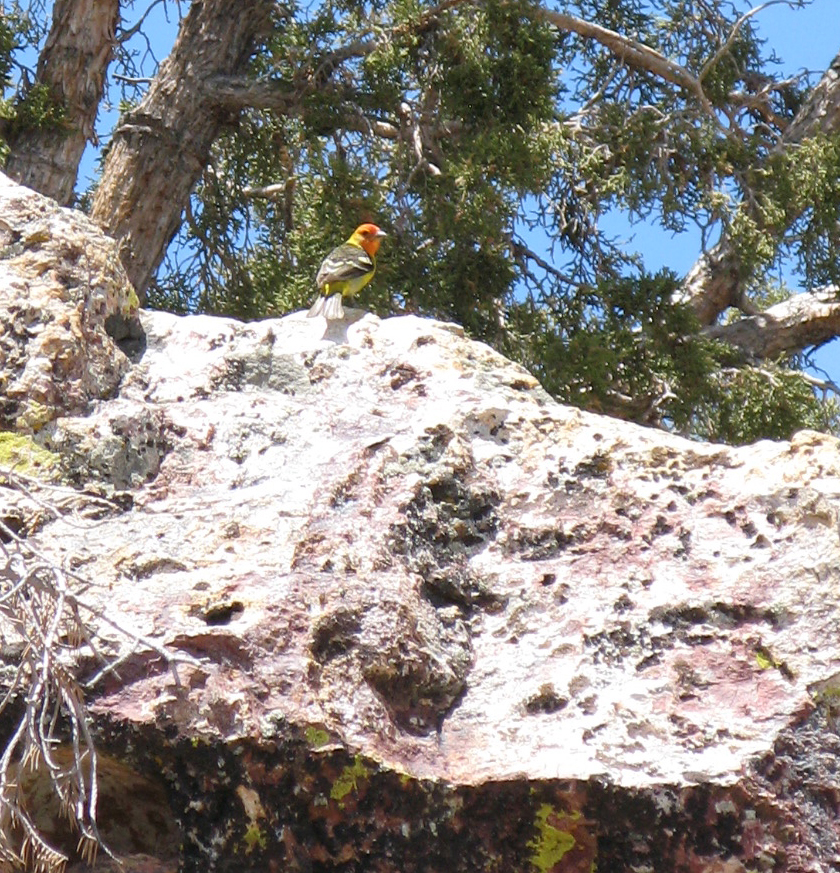 Although I never made a sketch, I was able to watch and photo a series of species — seven in all, ultimately, although I only could photo five — as they used this rock as viewpoint, shelter, sunning place, food storage or source. (All photos A.Shock; be sure to click on each image to enlarge for better viewing.)
Although I never made a sketch, I was able to watch and photo a series of species — seven in all, ultimately, although I only could photo five — as they used this rock as viewpoint, shelter, sunning place, food storage or source. (All photos A.Shock; be sure to click on each image to enlarge for better viewing.)
Birds landed on it briefly, including the Wilson’s warbler, and a vivid Western tanager male.
<< male Western tanager on the Rock
Being hydrothermally altered (so I’m assured by E), it was porous and full of useful cracks and refuges. A small movement caught my eye, and in the darkest crack in the darkest center of the sooty overhang, a Piñon deermouse 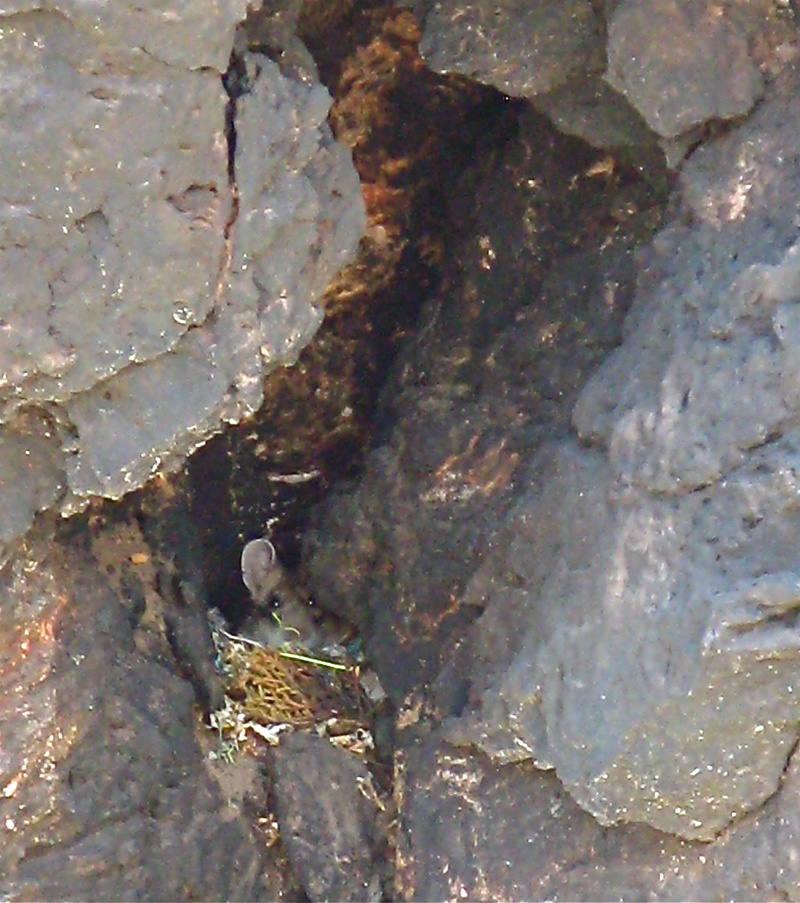 had packed the crevice with soft needles and moss, and was turning this way and that in its snug, sheltered nest, running tiny paws over its big ears.
had packed the crevice with soft needles and moss, and was turning this way and that in its snug, sheltered nest, running tiny paws over its big ears.
<< Piñon deermouse in crevice nest in the Rock
Best yet, I happened to look over at the upper dark hole in the rock just in time to see this little face peering out, checking on how things were in the middle of the day. It’s a Long-tailed weasel, a native here (unlike in New Zealand), but still an active and industrious predator. I was alarmed when the ground squirrel above made a short trip into the very hole the weasel had just gone back inside. But there was no disaster, and the squirrel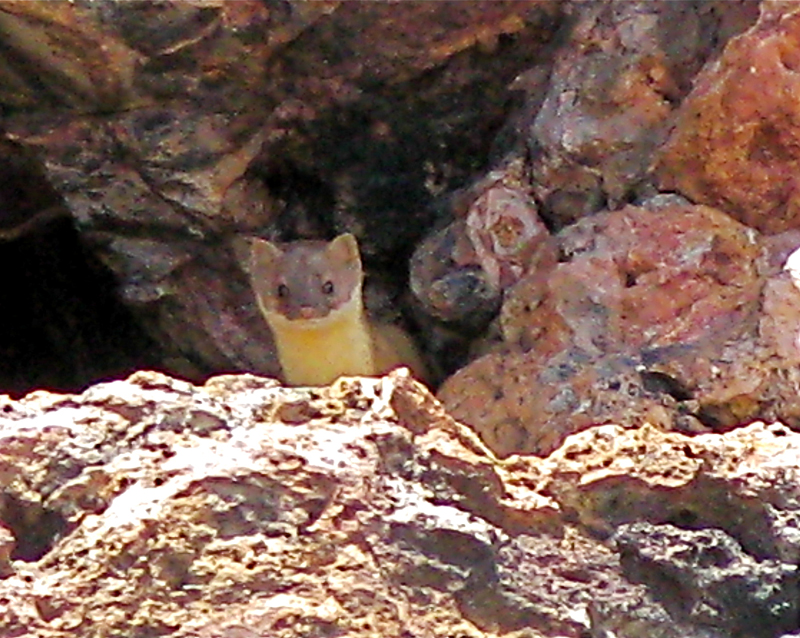 came right back out again, presumably with all its parts, and with no dramatic nature-show confrontation music to mark the event.
came right back out again, presumably with all its parts, and with no dramatic nature-show confrontation music to mark the event.
Long-tailed weasel outside its hole in the Rock >>
The seventh species I observed on the Rock was Homo sapiens. It was one of the two dudes that came by in a battered Isuzu Trooper (like the one I drove for years). Although I didn’t get a picture of him up on the top of the Rock, we were particularly glad to see this human being: something you won’t often hear me say. The reason he was a fine sight on this backcountry, rocky road? That’s another story. I won’t tell it here, except to say that it involved jumper cables…
It’s the most bunnerful time of the year
<< Two of these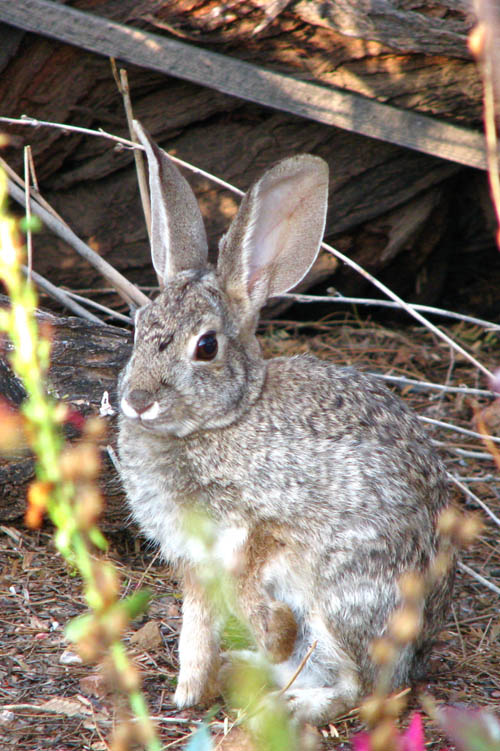 equals these. ↓
equals these. ↓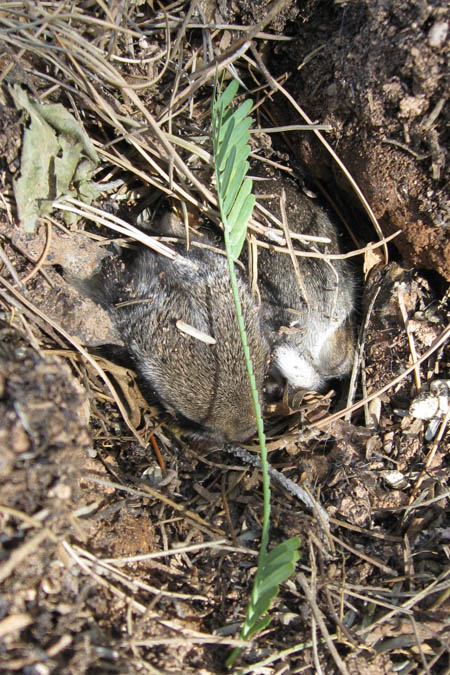
Desert cottontails abound in the yard right now. The desert is green from the late winter rains, so there’s lots to eat. Adult frolicking leads to tiny bunlets. The two in the photo above on the right were stashed by mom in a shallow scrape right out in the open. When we discovered them, while checking on the mantis egg case, they were barely 3 inches long. A day later, they were gone, leaving only the “form” behind in the mesquite leaf litter. Moved by mom, eaten, or hopped off under their own power, we’ll never know.
(All photos E.Shock)
Rio Salado in early spring
Today I actually got outdoors to breathe air, soak up sunbeams, and take a look at what’s up, and what’s in the air. It’d been awhile, and I thought I’d celebrate by passing along some of what’s 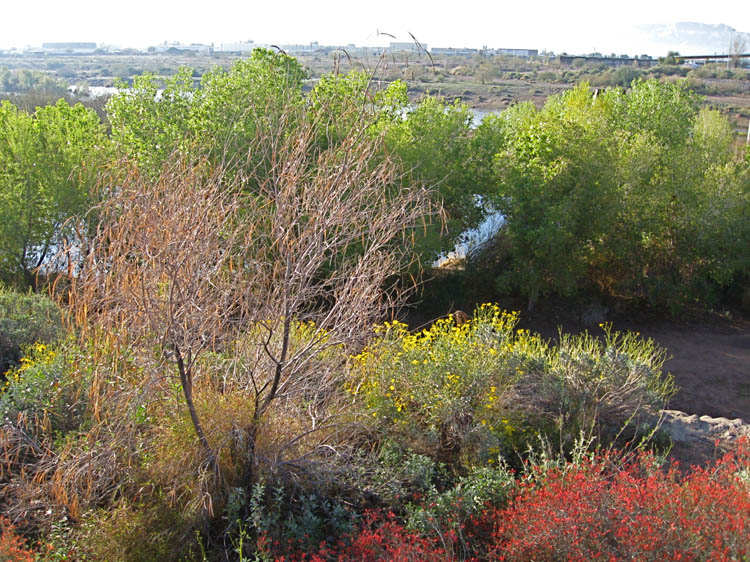 happening along the Salt River, smack in the middle of the City of Phoenix, AZ.
happening along the Salt River, smack in the middle of the City of Phoenix, AZ.
<< green Goodding’s willows, brittle bush, Desert willow, and chuparosa at Rio Salado; photo A.Shock
The Rio Salado Habitat Preservation Area, as it’s officially designated (here is the website), is an ex-horrific-riverside urban dump that’s been cleaned up and improved in order to attract and showcase permanent and migrating wildlife, including birds, mammals, and insects.
Along the Salt River just south of downtown Phoenix, the RSHPA is less than 10 miles downstream from the riparian area at Tempe Town Lake (see here), and has a variety of habitats, from mesquite bosque to shady bands of Goodding’s willows (the bright green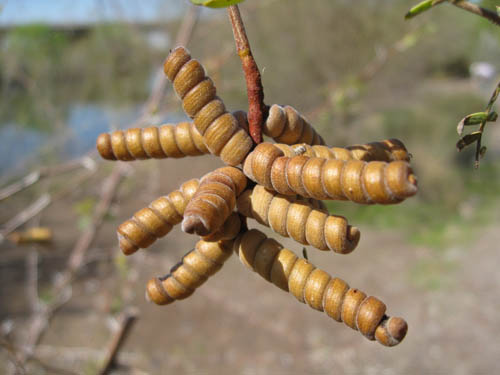 foliage in the photo above.) Each time I visit, the vegetation is better established, both naturally (Goodding’s willows are said to be able to grow something like six feet per year), and with the help of human hands — many native desert and riparian plants have been planted along the bike path and walking trails that weave along the river, on both sides. Right now, the Goodding’s willows are in bloom. The screwbean mesquites (right) are still bare, making their tightly-twisted seed pods stand out against the blue sky, clustered like little brown bouquets of rattlesnake rattles.
foliage in the photo above.) Each time I visit, the vegetation is better established, both naturally (Goodding’s willows are said to be able to grow something like six feet per year), and with the help of human hands — many native desert and riparian plants have been planted along the bike path and walking trails that weave along the river, on both sides. Right now, the Goodding’s willows are in bloom. The screwbean mesquites (right) are still bare, making their tightly-twisted seed pods stand out against the blue sky, clustered like little brown bouquets of rattlesnake rattles.
The river is high today after all of the rain in both the metro basin and in the high country north east of Phoenix, but it’s obviously been higher recently: big piles of flood debris are left on both sides of the trail. 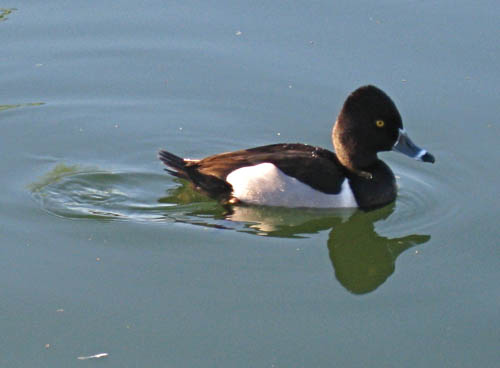 Cormorants (Double-crested and Neotropical), American coots, and Killdeer are common along the river, and the ponds and oxbows host a variety of waterfowl, like this handsome Ringnecked drake (left), Cinnamon teal, and Common moorhens. But we were especially on the lookout for dinky dudes — in this case, an out-of-range straggler, a Black and white warbler that’s been hanging out at the Rio for at least a week. It proved too dinky to photo, but we did get crippling looks at the tiny tourist, wrestling an enormous caterpillar into its gullet. It was keeping company with a Brown creeper, numerous Orange-crowned and Yellow-rumped warblers, Ruby crowned kinglets, a Blue-gray gnatcatcher, and other dinky dudes. A casual couple of hours of birding yielded a list of more than 35 species of birds, including a House wren.
Cormorants (Double-crested and Neotropical), American coots, and Killdeer are common along the river, and the ponds and oxbows host a variety of waterfowl, like this handsome Ringnecked drake (left), Cinnamon teal, and Common moorhens. But we were especially on the lookout for dinky dudes — in this case, an out-of-range straggler, a Black and white warbler that’s been hanging out at the Rio for at least a week. It proved too dinky to photo, but we did get crippling looks at the tiny tourist, wrestling an enormous caterpillar into its gullet. It was keeping company with a Brown creeper, numerous Orange-crowned and Yellow-rumped warblers, Ruby crowned kinglets, a Blue-gray gnatcatcher, and other dinky dudes. A casual couple of hours of birding yielded a list of more than 35 species of birds, including a House wren.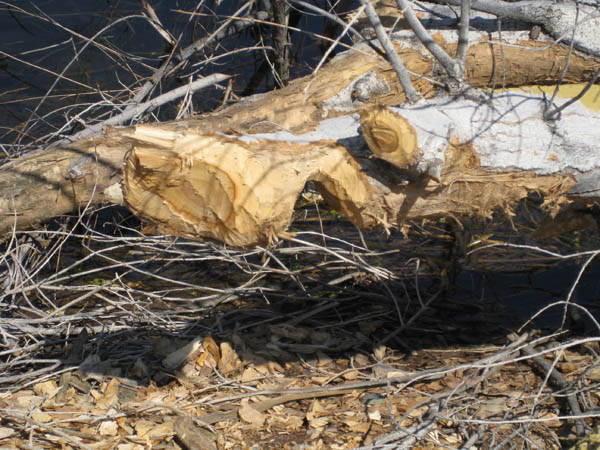
But for me, the surprise of the day was provided by our furry mammalian neighbors: there’s a beaver working the Rio! We didn’t see the critter itself, but check out the evidence of Beavers At Work. right >>
I love the industrious pile of wood chips under the chewed ends of this downed tree.
Anyone birding in the Phoenix area during autumn through spring seasons might wish to 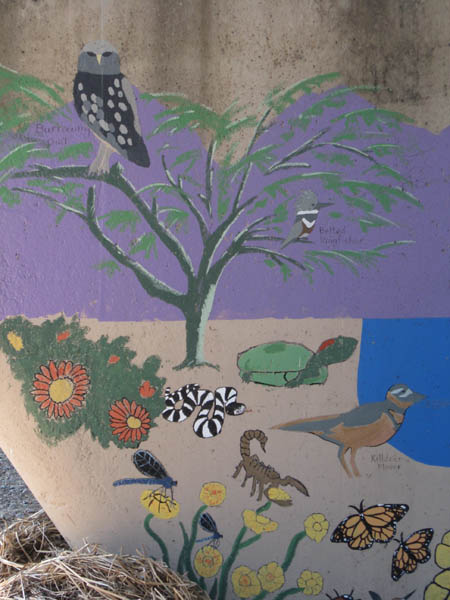 check out RSHPA .
check out RSHPA .
Remember — it’s an urban birding gem, so you might wish to bring a friend, and don’t leave anything valuable in your car.
Don’t be discouraged by the urban nature of this area, it’s got its advantages, too, like some really nice public art along the paths, and under the bridges on otherwise blank concrete supports.
>> Local wildlife painted under Central Ave bridge, RSHPA (all photos A.Shock)
Fair warning on this Black Friday…
…for those of us who decide to enter the Fray, this is the kind of thing you’ll be up against:
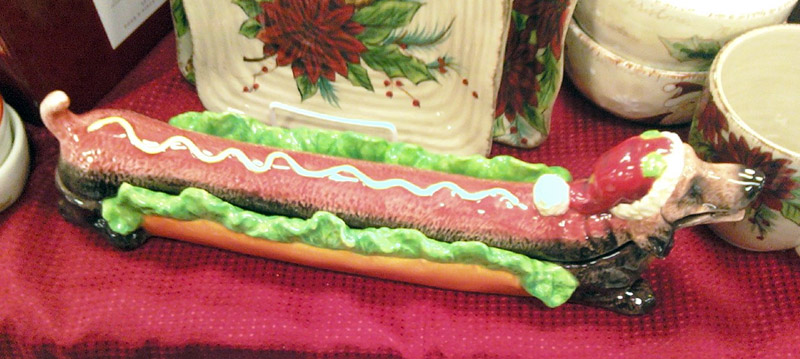 Yes, the Holidays must be upon us, it’s the traditional Santa Hat-Wearing Wiener Dog on a Bun with Lettuce and Mustard Effigy Vessel (featuring removable lid), now appearing at your local discount department store. Oh, Why didn’t I buy this when I saw it?
Yes, the Holidays must be upon us, it’s the traditional Santa Hat-Wearing Wiener Dog on a Bun with Lettuce and Mustard Effigy Vessel (featuring removable lid), now appearing at your local discount department store. Oh, Why didn’t I buy this when I saw it?
(cell phone photo A.Shock)
More coati moments
Spotting coatis in Sabino canyon was fortunate in many ways. Not only is it always amazing to see a coati, but it was artistically inspiring, too. Before the Tucson visit I had already begun a 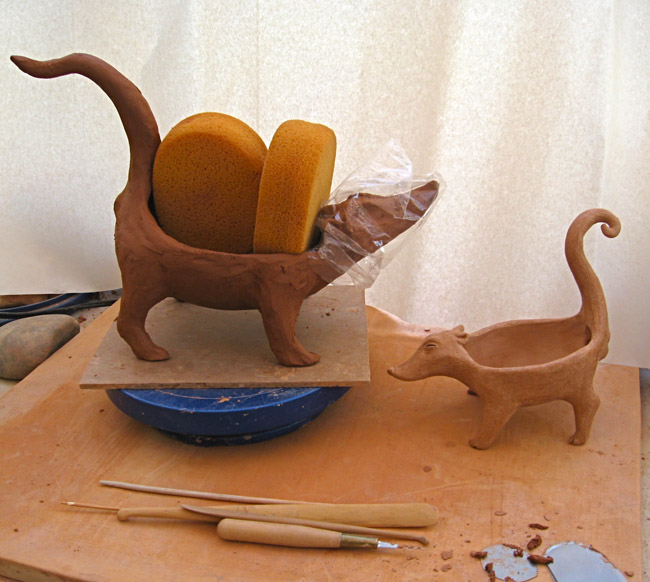 small coati effigy bowl, so on returning home I was all fired up to finish it and start another bigger one, images of live animals fresh in my head to draw from.
small coati effigy bowl, so on returning home I was all fired up to finish it and start another bigger one, images of live animals fresh in my head to draw from.
(left: pair of coati effigy bowls in various states of completion; photo A.Shock)
The little one is sculpted, textured, and burnished — bone-dry and awaiting bisque-firing. The bigger one is still wet, with sponges propping up a tail that wants to slump forward, and a plastic bag over the head to keep the snout workable for a little longer. (Our cool fall weather is keeping things drying at a snail’s pace, frustrating when you’re trying to get things through the studio rapidly, with the holidays coming up).
Sometimes clay places practical limitations on forms, and there’s no way to make tails as gloriously long and sinuous as real coati tails. But the snouty-shoulderyness of the climbing-digging critters is do-able, as is the higher-in back posture 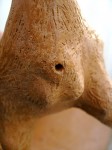 that makes them look like they’re always trundling downhill. These pieces are destined for sawdust-firing, I think, so the smoky coloration of the twilight-colored desert animals should be suitably earthy, but I’m still thinking about how to get the spectacles and the rings to be visible but not too contrasty.
that makes them look like they’re always trundling downhill. These pieces are destined for sawdust-firing, I think, so the smoky coloration of the twilight-colored desert animals should be suitably earthy, but I’m still thinking about how to get the spectacles and the rings to be visible but not too contrasty.
The little one is apparently a male. Be sure to click to enlarge.
(All photos A.Shock)
A Coati moment, or two
An excellent working weekend in Tucson had an unexpected furry, long-tailed highlight: on a hike up Sabino Canyon with Kate McKinnon and the other participants of her metal clay workshop, we ran into a pair of Coatis!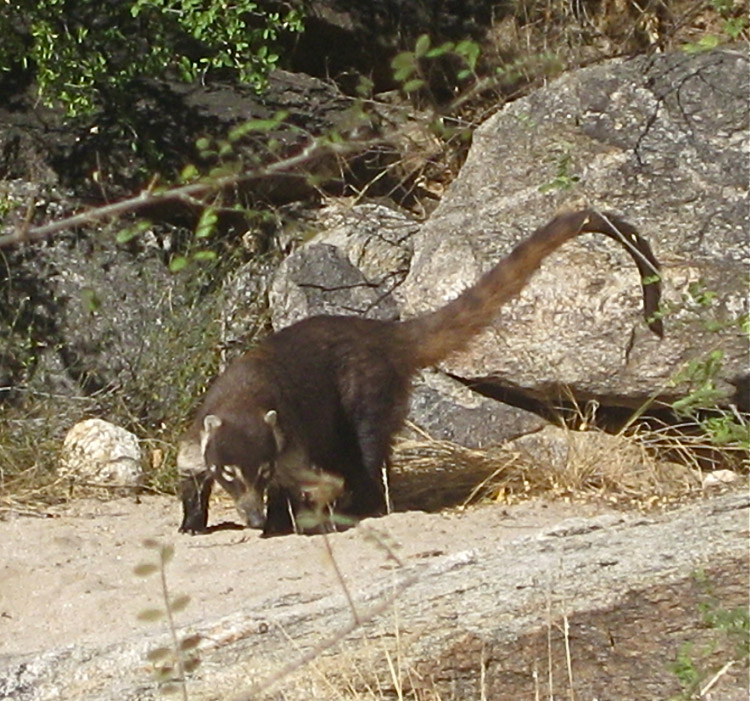 I’d forgotten my camera, but fortunately others had theirs, and the younger coati obliged us by being visible for a few minutes, nosing around for goodies among the grit and rocks in the hill above the stream-bed, so that everyone in the group got to see it.
I’d forgotten my camera, but fortunately others had theirs, and the younger coati obliged us by being visible for a few minutes, nosing around for goodies among the grit and rocks in the hill above the stream-bed, so that everyone in the group got to see it.
(Photo right by Kate McKinnon)
If you’re not familiar with the White-nosed coati (Nasua narica) — nicknamed Chulo — it’s a Sonoran desert native with a long, flexible snout, beguiling spectacle-markings, bear-like ears, a long prehensile tail, and clever grippy hands. They are related to raccoons and another snouty-taily mammal the Ringtail, all in the Procyonid family. They are at home in arid oak-sycamore woodlands and rocky desert canyons in the American southwest and regions south, all the way to Central and South America. Coatis are not uncommon in their range, but like owls, even though they’re there, you don’t often see them, even though they’re out and about during the early and late daylight hours.
A bit of luck for me, seeing these, because I’m working on a coati bowl right now for upcoming holiday shows, so the furry, fossicking inspiration was welcome.

